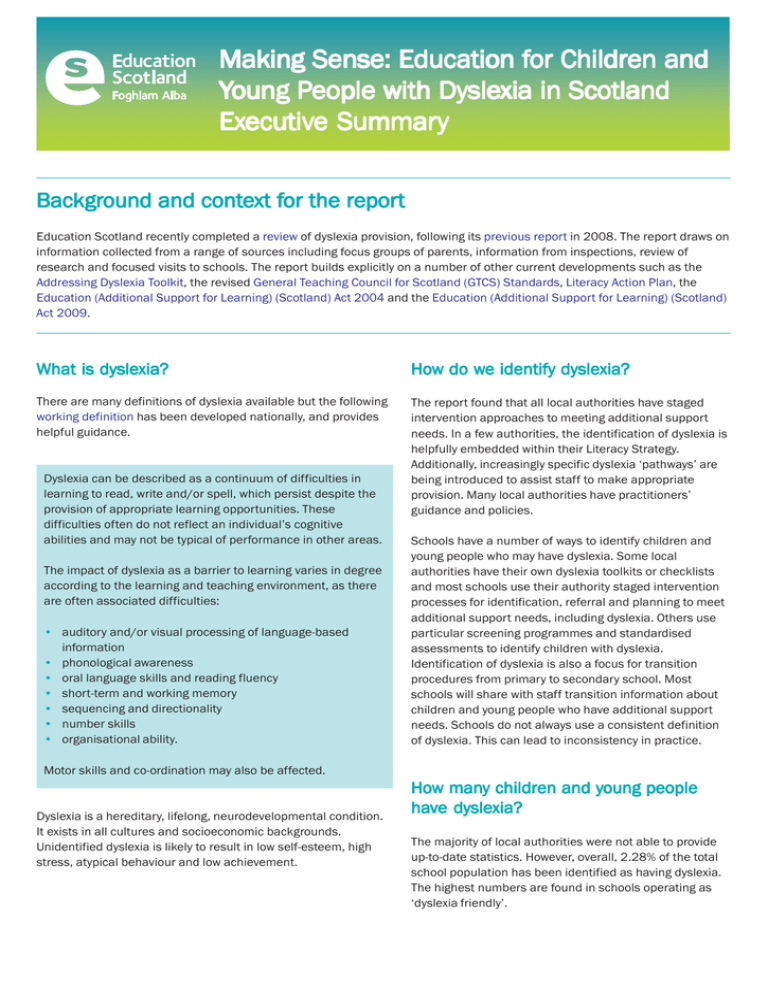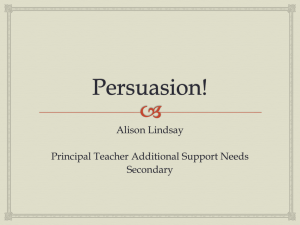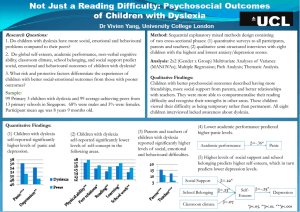Making Sense: Education f or Children and
advertisement

Making Sense: Education ffor or Children and Young P eople with Dysle xia in Sco tland People Dyslexia Scotland Ex ecutiv e Summar Executiv ecutive Summaryy Back gr ound and cont ext ffor or the repor Backgr ground conte reportt Education Scotland recently completed a review of dyslexia provision, following its previous report in 2008. The report draws on information collected from a range of sources including focus groups of parents, information from inspections, review of research and focused visits to schools. The report builds explicitly on a number of other current developments such as the Addressing Dyslexia Toolkit, the revised General Teaching Council for Scotland (GTCS) Standards, Literacy Action Plan, the Education (Additional Support for Learning) (Scotland) Act 2004 and the Education (Additional Support for Learning) (Scotland) Act 2009. What is dysle xia? dyslexia? Ho w do w e identify dysle xia? How we dyslexia? There are many definitions of dyslexia available but the following working definition has been developed nationally, and provides helpful guidance. The report found that all local authorities have staged intervention approaches to meeting additional support needs. In a few authorities, the identification of dyslexia is helpfully embedded within their Literacy Strategy. Additionally, increasingly specific dyslexia ‘pathways’ are being introduced to assist staff to make appropriate provision. Many local authorities have practitioners’ guidance and policies. Dyslexia can be described as a continuum of difficulties in learning to read, write and/or spell, which persist despite the provision of appropriate learning opportunities. These difficulties often do not reflect an individual’s cognitive abilities and may not be typical of performance in other areas. The impact of dyslexia as a barrier to learning varies in degree according to the learning and teaching environment, as there are often associated difficulties: • auditory and/or visual processing of language-based information • phonological awareness • oral language skills and reading fluency • short-term and working memory • sequencing and directionality • number skills • organisational ability. Schools have a number of ways to identify children and young people who may have dyslexia. Some local authorities have their own dyslexia toolkits or checklists and most schools use their authority staged intervention processes for identification, referral and planning to meet additional support needs, including dyslexia. Others use particular screening programmes and standardised assessments to identify children with dyslexia. Identification of dyslexia is also a focus for transition procedures from primary to secondary school. Most schools will share with staff transition information about children and young people who have additional support needs. Schools do not always use a consistent definition of dyslexia. This can lead to inconsistency in practice. Motor skills and co-ordination may also be affected. Dyslexia is a hereditary, lifelong, neurodevelopmental condition. It exists in all cultures and socioeconomic backgrounds. Unidentified dyslexia is likely to result in low self-esteem, high stress, atypical behaviour and low achievement. Ho w man oung people How manyy children and yyoung ha xia? havve dysle dyslexia? The majority of local authorities were not able to provide up-to-date statistics. However, overall, 2.28% of the total school population has been identified as having dyslexia. The highest numbers are found in schools operating as ‘dyslexia friendly’. 2 Ho ww ell do primar How well primaryy and secondar secondaryy schools plan tto o mee ied meett identif identified needs? In what w ays is assistiv e ttechnology echnology wa assistive being used tto o suppor supportt children and young people with dysle xia? dyslexia? All schools use their local authority’s staged intervention model as a basis for the planning. Planning is a collaborative process, usually between the class teacher and the support for learning teacher or other specialist staff. Planning documents such as individualised educational programmes (IEPs) are often used. The range of computerised assessments, interventions and supports available has expanded significantly over the last few years helping to promote feelings of confidence and empowerment. Whilst there are many proprietary brands of software, the basic functions are mainly voice recognition or text-to-voice and word processing, including predictive spelling. Increasingly, authorities and schools now work with CALL (Communication, Access, Literacy and Learning) Scotland to get the most from technology. In most cases schools have effective pastoral transitions for children about to move to secondary school, including those with dyslexia. However, after initial assessment teachers are often left to use this information as they see fit and the impact is not monitored. Classroom teachers benefit from careerlong professional learning relating to dyslexia. There is a need for greater consistency in the quality and content of courses. In what w ays do practitioner wa practitionerss adapt teaching appr oaches tto o mee meett approaches identif ied needs? identified Local authorities encourage schools to use a wide range of teaching approaches, depending on the profile of the child’s or young person’s needs, their capabilities, interests and motivation as well as their age and stage. Some of the more significant approaches to differentiating lessons for children and young people are: • Differentiation of materials, media, responses and homework • Multi-sensory approaches • Use of the Dyslexia Friendly Schools framework • Specific phonological awareness activities • Structured spelling programmes and strategies • Alternative methodology • Adaptations to the classroom environment • ‘Scaffolding’ tools to give structure to writing • Adaptation to text • Use of graded readers with age-appropriate content • Direct support from other children and young people, including paired reading • Direct support from other adults • SQA’s Additional assessment arrangements. Ho ww ell is the TToolkit oolkit being used? How well The Addressing Dyslexia Toolkit is a free online resource which aims to provide information and guidance for all staff involved with children and young people with dyslexia. Dyslexia Scotland is responsible for the resource and for keeping the content refreshed and relevant. Most staff in schools are aware of the Toolkit but a greater use of the Toolkit would help staff to meet more effectively the needs of children and young people with dyslexia. Ho ww ell does special school How well pr ovision mee pro meett the needs of children and yyoung oung people with dysle xia? dyslexia? Special schools meet many types of needs, which may not include dyslexia. In some cases dyslexia is identified through formal assessments before starting school. The planning and teaching approaches in special schools often focus on improving their literacy skills, supported by a higher staff-to-pupil ratio than in mainstream schools. Very few of the schools visited have been involved in any professional learning relating to dyslexia and only a minority of staff are aware of the Toolkit. 3 Ho ww ell does Initial TTeacher eacher How well Education (ITE) suppor eacher o supportt tteacher eacherss tto mee oung meett the needs of children and yyoung people with dysle xia? dyslexia? Most initial teacher education (ITE) institutions have some sort of input on inclusion which ensures that students are made aware of the types of additional needs they may encounter including dyslexia. Almost all courses include reference to the Toolkit, with some having online workshops or modules on the resource. Many of the institutions are also making a direct link between dyslexia and the development of literacy skills in children and young people. The report found that STEC (Scottish Teacher Education Committee) needs to work with GTCS, Education Scotland and all ITE institutions to ensure consistency of teacher training courses in relation to dyslexia. What are the vie ws of parents and views carer s? carers? Parents and carers of children and young people who have dyslexia report a number of inconsistencies in their education. However, not all parental experiences are negative. Parents feel that: • some teachers have a good understanding of the needs of children with dyslexia; and • most schools can make appropriate provision for children with dyslexia once their needs have been assessed. Parents considered there are many similarities in the issues they have encountered and there are aspects for development. Parents think that: • schools should take better account of their views regarding the needs of their child; and • local authorities should ensure that teachers and senior managers have a good working understanding of dyslexia, along with direct access to the Toolkit. The Toolkit has been designed to be accessible to parents/carers, children and young people. © iStock 2014. All rights reserved. Ho w reliable is the data w e ha How we havve relating tto o dysle xia in schools? dyslexia The Scottish Government continues to improve and extend data collection and analysis in relation to additional support needs, which is resulting in improved information about qualifications and positive destinations. The report recommends that the Scottish Government should continue to improve the quality and reliability of the data which it collects. What does the data ttell ell us? The report found that local authorities have wide variations in the percentage of children and young people identified as needing support for dyslexia. The Scottish Government could improve the advice and guidance for census submissions to achieve greater consistency of submissions. In almost all local authorities a greater proportion of young people is identified as needing support for dyslexia in secondary schools compared to those in primary schools. The tariff scores show that young people with dyslexia may achieve broadly similar numbers of awards but they do not achieve as highly as the ‘average’ young person in school. Young people with dyslexia attain significantly less well than their peers in those qualifications which would enable them to apply for places at university. 4 What is the rrole ole of career -long career-long pr of essional learning and pr of essional prof ofessional prof ofessional recognition? Professional learning opportunities related to dyslexia are variable and should be increased. The GTCS also runs a ‘Professional Recognition’ scheme which allows teachers to focus their professional learning in particular areas of interest and gain recognition. Teachers who have been involved in making provision to meet additional support needs should consider applying for GTCS Professional Recognition. Training providers should have professional courses relating to additional support needs accredited. © iStock 2014. All rights reserved. Findings and recommendations • Local authorities are improving services for supporting learners with dyslexia. • Primary, secondary and special schools are generally making good provision for children and young people with additional support needs, including dyslexia but this needs to be more consistent. • Professional learning opportunities related to provision for those with dyslexia is variable and should be increased. • The Scottish Government Literacy Action Plan is committed to working with Dyslexia Scotland to address literacy difficulties and it is now providing a focus on early intervention to help children develop these skills. • Teachers, support staff, learners and parents should have access to up-to-date practical advice and guidance on dyslexia. • Teachers, support staff and local authority staff should have access to a wide range of high quality career-long professional learning opportunities at school, local and national level related to meeting the needs of children and young people with dyslexia. • Initial Teacher Education and postgraduate awards and courses should give a high priority to developing knowledge and skills in relation to dyslexia and additional support needs. • Schools, local authorities and national partners should take action to improve the quality of educational outcomes for children and young people with dyslexia. • The availability and use of reliable information relating to children and young people’s needs, development and achievement should be improved. The Scottish Government response to the report was published on 27 June 2014. The Dyslexia Learning Trail may be helpful as part of a school’s self-evaluation. Further information, including the Dyslexia Learning Trail, can be found at http://bit.ly/makingsense14. T +44 (0)141 282 5000 E enquiries@educationscotland.gov.uk W www.educationscotland.gov.uk Denholm House, Almondvale Business Park, Almondvale Way, Livingson, West Lothian. EH54 6GA © Crown copyright, 2014 You may re-use this information (excluding logos and images) free of charge in any format or medium, under the terms of the Open Government Licence providing that it is reproduced accurately and not in a misleading context. The material must be acknowledged as Education Scotland copyright and the document title specified. To view this licence, visit http://www.nationalarchives.gov.uk/doc/open-government-licence/ore-mail: psi@nationalarchives.gsi.gov.uk Where we have identified any third party copyright information you will need to obtain permission from the copyright holders concerned.






